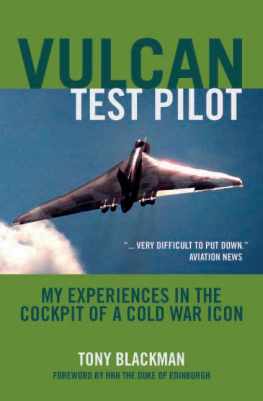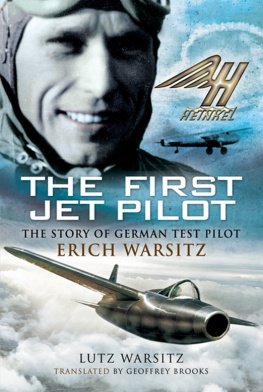
Books by same author
Autobiography:
Flight Testing to Win
ISBN 1-4116-4825-0
Mystery Fictiona Trilogy:
A Flight Too Far
A mysterious disaster at Heathrow
ISBN 0-9553856-3-6
The Final Flight
A Bermuda Triangle mystery
ISBN 0-9553856-0-1
The Right Choice
An aviation story of deceit and disaster
ISBN 0-9553856-2-8

Published by
Grub Street
4 Rainham Close
London
SW11 6SS
Copyright Grub Street 2009
Copyright text Tony Blackman
Copyright introduction HRH The Duke of Edinburgh
First published in hardback 2007
This edition first published 2009
British Library Cataloguing in Publication Data
Blackman, Tony
Vulcan test pilot: my experiences in the cockpit of a Cold War icon
1. Blackman, Tony 2. Vulcan (Jet bomber)
I. Title
623.74630941
ISBN-13: 9781906502300
eISBN: 978-1-908117-95-3
All rights reserved. No part of this publication may be reproduced, stored in a retrieval system, or transmitted in any form or by any means electronic, mechanical, photocopying, recording, or otherwise, without the prior permission of the copyright owner.
Cover design by Lizzie B design
Typeset by Pearl Graphics, Hemel Hempstead
Printed and bound by MPG Ltd, Bodmin, Cornwall
Grub Street Publishing only uses
FSC (Forest Stewardship Council) paper for its books.
DEDICATION
First of all I want to dedicate this book to Roly Falk and to Jimmy Harrison; their superb test flying helped to make the Vulcan such a wonderful and effective aircraft and they, alas, can no longer relate this incredible story themselves.
The other dedication I want to make is to Margaret my wife. She was my editor, my proof reader and knew almost as much about the Vulcan as I did by the time the book was finished. Together we went to Bruntingthorpe, to the National Archives and to the publisher and she was an everlasting inspiration and ideas person. We were both at Boscombe when the Vulcan arrived and I am sure being the first lady to fly in the co-pilots seat also helped. I consider myself very fortunate to have had such outstanding support.
ACKNOWLEDGEMENTS
I have had an enormous amount of help and support writing this book so it is difficult to know where to begin. However, perhaps I should start with Peter Clegg who has given me so much material, unstinted support and saved me years of work.
One of the splendid pleasures I have had researching the book was making contact again with so many old friends and colleagues and if I have left someone out I hope they will forgive me. Wason Turner was in charge of the technical office in B Squadron at Boscombe Down when I was there and it was a real pleasure to work with him again. He has helped me enormously in making sure that this book is not a work of fiction and providing me with the graphs of the measurements we made at Boscombe Down.
At Avros, Harry Holmes was in the marketing department and Mike Taylor in the flight test office at Woodford in my time; they found invaluable photos, documents, and flight test reports for me besides advising me and jogging my memory. John MacDaniels book Tales of the Cheshire Planes was another useful technical source that I needed, as was Laurie Trier on Vulcan structures and the frailties thereof. Bob Pogson was my AEO and he reminded me of extra things that I had forgotten. I have almost forgiven him for flying in even more Vulcans than I did.
Researching accidents was a difficult but important task and I would like to thank Mary Hudson of the Historical Branch, and Peter Elliott of the Royal Air Force Museum for pointing me in the right direction. I would also like to express my unbounded admiration for the National Archives.
From the other side of the world in Canberra, I would like to thank John Saxon for helping me with the Blue Steel story and Milt Cottee for setting the speed limit of the Vulcan Mk 1, telling me about it and, of course, flying with me all those years ago.
I was also lucky in getting help from old Royal Air Force Vulcan aircrew, Peter Lawrence, Rod Powell and Roy Ashton amongst others.
Some of the basic Vulcan information I garnered from web sites and in particular I used Guy Bartletts which was a mine of information. With regard to photos, I have tried to acknowledge all as appropriate but if I have missed any out or got some wrong please let me know and I can only apologise.
Finally, any mistakes which have crept in are, of course, entirely my responsibility.
FOREWORD

APPRECIATION
I am so glad to have the opportunity to say thank you to Tony for writing this splendid book. Among the many books written about the Vulcan this one is unique in describing so well, in mainly non technical terms, the birth pangs of the aircraft and the work it took to make it such an outstanding success.
Not surprisingly, one of the things I really liked about this book was the fact that Tony realised that Roly not only tested the Vulcan but also sold it to the Royal Air Force, the politicians and above all, to the public, including the time he rolled the Vulcan for the first time at the Farnborough Air Display in 1955. Of course Tony has been able to write this account first hand because he was so intimately involved; Roly recruited Tony and he took over the Vulcan testing with Jimmy Harrison.
The Spitfire is the aircraft icon of the Second World War and, thanks to Roly, Jimmy, Tony and RAF crews, the Vulcan is the aircraft icon of the Cold War. There are quite a few Spitfires still flying but to get a Vulcan flying again would be a magnificent achievement and this book will be a fitting backcloth to XH558 display flying again and will remind those who fly it, and those who watch, of the hard work that took place to make it all possible.
Leysa Falk
INTRODUCTION
There have been various books written about the Vulcan, telling in great detail the operation of the aircraft and maybe a little bit about the early years. However, as far as I know there has never been a book written about test flying the Vulcan by someone who was actually there at the time doing a lot of the flight testing. The aerodynamic shape of the Vulcan had some unusual flying characteristics which needed to be dealt with; its relatively benign flying qualities didnt happen by accident! This book explains how the aircraft was made to work and be safe to fly.
It seemed an ideal time to write it to celebrate Vulcan XH558 flying again, forty-six years after I first flew it on its production schedule. I not only tested the aircraft then but, as it was the first Mk 2, I delivered it to Waddington, and flew it again five years later after modifications had been fitted. During my research I found that I had flown 105 of the aircraft out of the 136 built, 850 flights and 1,327 hours. However Bob Pogson, our main Avro AEO who controlled all the vital electrical power in the aircraft, soon put me in my place as he had flown in 123 Vulcans and, recently, I met a 9 Squadron AEO who had achieved 3,500 hours but I dont know how many flights he had done.
The sort of flying 558 is going to do is of course all display flying and so this book fits in very well, since at Woodford where the aircraft were built, we not only tested the Vulcan but we used to do demonstration flying at Farnborough and the history of these demonstrations is discussed.
















